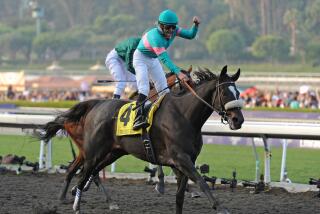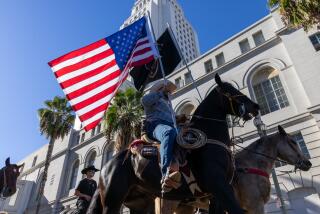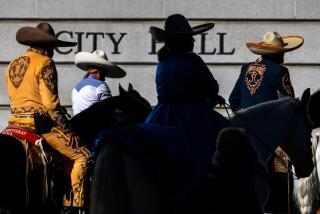Battered bull rider struggles for eight seconds of fame
Bulls ripped open his chin, blackened his eyes and broke his nose, ribs and legs — the right leg three times.
But that all paled in comparison to what happened about a year and a half ago, when Beau Schroeder climbed on a snorting, bucking 1,800-pound monster called 800 Night Moves.
------------
FOR THE RECORD:
Texas bull rider: An article in Section A on Aug. 7 about bull rider Beau Schroeder said McNeese State University, where he won a rodeo scholarship, is in Lafayette, La. It is in Lake Charles, La. —
------------
The bull threw him into the red dirt of the arena in Fort Mojave, Ariz. Its massive hooves trampled his chest, punctured his lungs and tore open his throat.
He couldn’t walk. He couldn’t talk. He could barely breathe.
Schroeder was flown to a hospital in Las Vegas. Someone called his mother, who at first figured he had suffered just another bull-riding injury — at worst, a broken jaw. Instead, her son lapsed into a coma for eight hours.
He was hospitalized for eight days. When he was discharged, all he could think about was getting back on a bull. That pretty much sums up the life of a bull rider.
Rodeos are 1 1/2 times more injurious than boxing, 10 times more than football and 13 times more than ice hockey. Some bull riders claim to have suffered more than a dozen concussions. Still, they cling to their calling.
Two months after his encounter with 800 Night Moves, Schroeder was back on a bull.
Rodeo went pro years ago, with trainers, leagues, sponsors, TV coverage and big money to be made. But it remains an all-American proving ground, where brave young men become legendary cowboys.
“Rodeo riders are today’s gladiators,” Schroeder said.
Apple-cheeked at 26, Schroeder has tousled brown hair and a small frame, like most bull riders; he is lean and fit at 5 feet 10 and 160 pounds.
He comes from China, Texas, a tiny rice farming town east of Houston named for its chinaberry trees. He started riding calves when he was 5. He later attended McNeese State University in Lafayette, La., on a rodeo scholarship.
He was nicknamed Beau, after a favorite family dog. His real name is Victor Karl, after two other former bull riders: his father, Victor “Punkee” Schroeder, and grandfather Victor “Ickey” Schroeder.
This spring, Schroeder competed at the Houston Livestock Show and Rodeo, the largest rodeo in the world. As 70,000 fans waited at NRG Stadium, he and the other bull riders gathered in a dusty parking lot, packing up road-worn bags with spurs, chaps, mouthpieces and protective vests.
Schroeder grabbed the black helmet he wore the day of his near-fatal injury. His throat still bore the pebbly scar, like buckshot trapped under his skin.
“Just think what would have happened if I hadn’t had it on,” he said.
Some of his buddies were not convinced. Elliot Jacoby, 23, tapped his straw cowboy hat.
“This is my helmet,” he said.
Rodeo helmets with metal face masks are required by law in Texas for those younger than 18. But some riders balk, protesting that the helmets weigh them down and block their view if they are thrown.
It took bull riders dying in the ring to get competitors to start wearing safety vests in the 1990s.
In 1989, Lane Frost, 25, was gored at a rodeo in Cheyenne, Wyo., a death immortalized in the movie “8 Seconds.” Five years later, Brent Thurman, also 25, was trampled at the national finals and died a few days later.
Neither wore a vest or helmet.
The week before Schroeder competed at Houston, he witnessed one of the bloodiest head injuries he had ever seen. At a rodeo in Okeechobee, Fla., the back of a bucking bull’s head hit 21-year-old Jeffrey Ramagos in the face, a catastrophe riders call “kissing the bull.” He did not have a helmet.
“It looked like his face was torn off,” Schroeder said.
Ramagos vowed to keep bull riding.
Schroeder has won 35 buckles, which are on display under glass in his wagon wheel coffee table, plus three ornamental saddles with seats made from blue alligator, ostrich and stingray. He has a girlfriend, a medical assistant in Nacogdoches. But like most bull riders, he lives on the road in a pickup fitted with a trailer, and has beds and a shower. Two years ago, he competed in 112 rodeos and won $264,000. The same year, he won the top bull riding buckle here, took home more than $56,000 and competed at the national finals.
Before his first round of competition in Houston this spring, Schroeder stopped by the rodeo clinic. A chiropractor remembered him.
“I’m not really sleeping good at night,” Schroeder said. “I feel like I’m sitting on my tailbone all the time, like I can’t get away from it.” The chiropractor got to work on his back. Schroeder’s eyelids fluttered and he started groaning. She showed him a few stretches, and urged him to return the next two nights of competition. He wondered aloud what the problem might be. The chiropractor was blunt: “It’s the riding bulls part, I’m afraid.” Schroeder slipped a wrap over his left knee, the one a bull stepped on in Denver. Then he left to suit up.
He sidled behind the chutes in the massive arena that smelled of stale beer, popcorn and manure. He was scheduled to ride a black and white-tipped bull called White As. He had ridden the bull before and won. It had gained a lot of weight since then.
He settled into the saddle, kissed a cross hung around his neck and pulled on his helmet.
As the chute opened, the bull kicked and reared. Schroeder tried to get a firm grip, but lost his hold on the rope. In seconds, he was on the ground, trapped between the arena’s metal bars and the bull’s sharp hooves. Just in time, a rodeo clown ran up to distract the beast while Schroeder leaped to safety.
In the end, only three of the riders in his round managed to last the eight seconds required to score.
Afterward, Schroeder’s back ached worse than ever, but he endured the pain to meet fans and sign autographs.
That’s when he ran into a trainer he had known since high school. The trainer took him to the on-site clinic for an X-ray.
Schroeder emerged looking stunned.
“My back’s broke.”
The X-ray had revealed an old fracture in his tailbone.
The trainer scheduled Schroeder for an appointment with a physical therapist and recommended pain medicine. “We’ll just treat him and try to keep his pain to a minimum so he can win some money,” the trainer said. He didn’t bother telling the cowboy to stop riding. There was no use in that. Schroeder had two more nights to compete. Then he planned to ride again at Fort Mojave, the rodeo where he had almost died.
molly.hennessy-fiske@latimes.com
More to Read
Start your day right
Sign up for Essential California for news, features and recommendations from the L.A. Times and beyond in your inbox six days a week.
You may occasionally receive promotional content from the Los Angeles Times.







